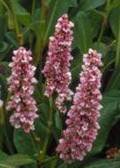 Himalayan Fleeceflower is a creeping, mat forming herbaceous perennial native to the montains of Tibet, Nepal, northern India, Pakistan, and Kashmir where it grows on slopes, wet areas, and screes. It is a member of the knotweed family, Polygonaceae, that includes rhubarb, buckwheat and some infamous weeds. The broadly lanceolate leaves are mostly basal, two to four inches long, and tapered at the petiole end. They are dark green during most of the growing season but turn bronze in the fall. The funnel -shaped, rose-red flowers appear from summer to early fall on leafless stems in terminal dense cylindrical spikes two to three inches long. They bloom over a long time, turning pink and then white as they mature. Plants do best in cool moist climates and are drought tolerant. They are useful as a ground cover, for erosion control on banks, at the front of a border, or in a rock garden. The genus name Polygonum comes from the Greek poly- meaning many and goni meaning knee or joint and refers to the swollen nodes on the stems of some species, including this one.
Himalayan Fleeceflower is a creeping, mat forming herbaceous perennial native to the montains of Tibet, Nepal, northern India, Pakistan, and Kashmir where it grows on slopes, wet areas, and screes. It is a member of the knotweed family, Polygonaceae, that includes rhubarb, buckwheat and some infamous weeds. The broadly lanceolate leaves are mostly basal, two to four inches long, and tapered at the petiole end. They are dark green during most of the growing season but turn bronze in the fall. The funnel -shaped, rose-red flowers appear from summer to early fall on leafless stems in terminal dense cylindrical spikes two to three inches long. They bloom over a long time, turning pink and then white as they mature. Plants do best in cool moist climates and are drought tolerant. They are useful as a ground cover, for erosion control on banks, at the front of a border, or in a rock garden. The genus name Polygonum comes from the Greek poly- meaning many and goni meaning knee or joint and refers to the swollen nodes on the stems of some species, including this one.
Type: Herbaceous perennial
Bloom: Funnel-shaped, rose-red flowers in terminal dense cylindrical spikes two to three inches long from summer to early fall; turn pink and then white as they mature.
Size: 6-9” H x 12” W
Light: Full sun; tolerates some shade.
Soil: Organically rich, moderately moist to dry, well-drained
Hardiness: Zones 3-7
Care: Deadhead to prolong bloom time
Pests and Diseases: None of significance
Propagation: Division, seed
Companion plants: Japanese painted fern, Lysimachia clehthroides
Outstanding Selections:
‘Darjeeling Red’ (deep pink flowers; vigorous)
‘Donald Lowndes” (8-10″ tall; double salmon-pink flowers)
‘Superbum’ (Vigrous; pink flowers turn crimson with age)